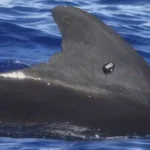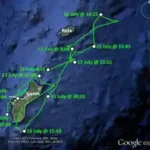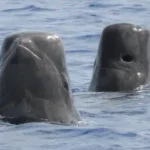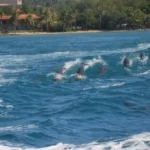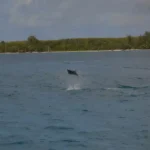Tuninos: Dolphins and Their Cousins in Guam Waters
Table of Contents
Share This
Short-Finned Pilot Whales (Globicephala macrorhynchus)
Classification, appearance and local distribution
Pilot whales are in the dolphin family (Delphinidae), which is part of the oceanic dolphins. The name “pilot” was came from the thought that one whale piloted the group. They are widely distributed and are currently recognized as two types: short-finned and long-finned. Although there is some evidence that the short-finned type may be two or more species, they are still classified as one type. The long-finned pilot whales are usually found in colder temperate conditions, while the short-finned live in warm tropical waters.
On Guam, short-finned pilot whales have been sighted and recorded near Urunao and Togcha. In a June-July 2013 Marianas cetacean NOAA survey, three satellite-tagged pilot whales from Guam were tracked swimming to Tinian, Rota, the southwest side of Guam and Galvez Banks (about 12 miles south, southwest of Guam).
Although it is difficult to tell the two species apart, short-finned pilot whales have smaller flippers and fewer teeth than the long-finned pilot whales. Pilot whales are the second largest oceanic dolphin after the killer whale, and their size ranges from 4 to 8 meters and 2,200 to 6,600 pounds. Coloration of short-finned pilot whales is usually jet black or dark grey. They have a grey saddle-patch below the dorsal fin and a white-grey elongated anchor shape on their underside. What makes them distinctive in appearance is their bulbous head, lack of a beak, and a large dorsal fin that is further forward on its back than other whales or oceanic dolphins.
Life history
Pilot whales are very social animals; they travel in schools of 25 to 50 individuals that are comprised of close family relatives. Usually, there is one male per eight females in the group and they can have more than one mate. Sexual maturity is reached at about 10 years and females have, on average, one calf every five to eight years. Females usually stay with their pod their whole life, while males travel between pods. Males live, on average, for 46 years and females live an average of 63 years.
The pilot whales main diet consists of fish, octopus and squid. Squid is their main food of choice and are caught by hunting together in high-speed chases. They can swim up to 20 mph for distances of about 650 ft. The tagged pilot-whales from Guam were found to dive to 1,160 meters. Short-finned pilot whales have a few predators: killer whales and large sharks.
Pilot whales are found near deep continental shelves and will allow boats to get near to them. They are sometimes seen resting in a “logging” behavior where they all face the same direction and float like logs. They are rarely seen breaching, but instead they ‘lob tail’, which is slapping their flukes on the water surface. Another common behavior is ‘spy hopping’, which is poking their head above the surface.
Another common strange behavior for these animals are their mass stranding events. Mass strandings involve a whole school of whales beaching themselves on shore, resulting in their deaths. The cause of this behavior is unknown, but is associated with high levels of sound created from military sonar or seismic exploration. The first and only documented beached pilot whale on Guam was on 6 July 1980 at Togcha Beach, Yona.
Local significance
Whaling near Guam from 1822 to the early 20th century mainly caught humpback whales, so pilot whales may have been largely unaffected. During this time, foreigners would come to hunt during whaling season. Currently in the Marianas islands, all marine mammals are protected under the Marine Mammal Protection Act and are illegal to hunt. However, whaling for short finned pilot whales does still occur in Japan and their fishing practices were featured in a controversial Oscar-winning documentary, “The Cove.”
Spinner Dolphins (Stenella longirostis)
Classification, appearance and local distribution
Spinner dolphins are named for their performance of multiple spins when jumping out of the water. There are four subspecies that live in warm tropical waters worldwide; the Eastern spinner dolphin (S. l. orientalis) found in the eastern Pacific Ocean, Central American spinner dolphins (S. l. centroamericana) found in the western Central America and southern Mexico, dwarf spinner dolphin (S. l. roseiventri), found in northern Australia and Southeast Asia, and Grays spinner dolphin (S. l. longirostris) found in pan-tropical waters.
A resident spinner dolphin on Guam is the Stenella longirostis, which can be spotted on the leeward side of the island in areas such as Double Reef, Hågat Bay, Bile Bay or Malesso’ Bay. Many tour companies on Guam offer dolphin watching excursions to see the spinner dolphins’ acrobatic displays.
Spinner dolphins are known for their tri-color pattern of dark grey on the back, lighter grey on the sides and a white belly. They are torpedo shaped, with a long snout and triangular shaped dorsal fin. They are the smallest species of dolphin, averaging 2 to 2.5 meters in length and weighing between 130 to 170 lbs.
Life history
Spinner dolphins live in pods of 20 to 200. They have a daily migratory cycle of resting in shallow, clear open water with sandy bottoms during the day and then moving to deeper waters at night for feeding. They eat mesopelagic small fish, squid, prawns and eels. Tuna are often seen with spinner dolphins hunting for food in a presumed mutualistic relationship.
The estimated lifespan of spinner dolphins is 20 years. Females reach maturity after five years and have one calf every three years. Many males may mate with one female and sexual interactions can also occur in male-male pairs.
Spinner dolphins are most known for their energetic aerial behaviors of leaping, spinning, backslaps, headslaps and tailslaps. Scientists believe these movements are a form of communication, a way to remove parasites and water from their respiratory tract, and also just for fun. Around boats, they are curious and playful and enjoy surfing in the wake, making them definitely an attraction for people to watch.
Local significance
Dolphins, known as tuninos in CHamoru/Chamorro, are an important tourist attraction on Guam. They are also a mascot for Guam’s Southern High School, “the home of the dolphins.” Although dolphins are loved by people, tourism and development may affect their resting habitat in nearshore waters. Another main threat is entanglement in fishing nets. Since tuna hunt alongside spinner dolphins, many are caught as by-catch.
About the author

Melissa Gabriel, PharmD, was a Master of Environmental Science candidate at the University of Guam, EPSCoR research assistant at the Marine Lab and pharmacist. She is a returned resident to Guam who is studying the health of Guam’s coral reefs and also working in the healthcare profession in a community and hospital setting.
Editor’s note: This author was beginning graduate student in 2018 taking a course in scientific writing at the University of Guam. This article was assigned to provide the student with practice in communicating science to non-scientists. The student chose the topic which is related either to their thesis project or work experience. The instructor in the course is Dr. Laurie Raymundo, a UOG Marine Laboratory faculty member.
For further reading
Bearzi, Giovanni, Arne Bjørge, KA Forney, PS Hammond, Leszek Karczmarski, T. Kasuya, William F. Perrin, Michael D. Scott, Jingzhen Y. Wang, RS Wells, and Barnaby Wilson. “Stenella longirostris.” The IUCN Red List of Threatened Species 2012. Cambridge: International Union for Conservation of Nature and Natural Resources, 2012.
Britannica, The Editors of Encyclopaedia. “Pilot Whale.” In Encyclopaedia Britannica, 20 July 1998.
Eldredge, LG. “The Marine Reptiles and Mammals of Guam.” Micronesica 35-36, (2003): 653- 660.
Fulling, Gregory L., Philip H. Thorson, and Julie Rivers. “Distribution and Abundance Estimates for Cetaceans in the Waters off Guam and the Commonwealth of the Northern Mariana Islands.” Pacific Science 65, no. 3 (2011): 321-343.
Hill, Marie, Allan Ligon, Adam Ü, and Mark Deakos. “Marianas Cetacean Surveys 2013: Rota Summary (July 4 – 10).” NOAA Pacific Islands Fisheries Science Center Blog, 15 July 2013.
MarineBio Conservation Society. “Pilot Whales, Globicephala macrorhynchus.” Last modified 25 May 2020.
McNulty, Robert Weybright. “Marine Mammal Monitoring on Guam.” Oregon Undergraduate Research Journal 4, no. 1 (2013): 54-72.
National Oceanic and Atmospheric Administration Fisheries. “Spinner Dolphin.” Last modified 12 May 2025.
Taylor, B., R. Baird, J. Barlow, S. Dawson, J. Ford, J. Mead, G. Notarbartolo di Sciara, P. Wade, and R. Pitman. “Globicephala macrorhynchus.” The IUCN Red List of Threatened Species 2011. Cambridge: International Union for Conservation of Nature and Natural Resources, 2011.

